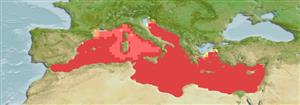Tetrapturus belone Rafinesque, 1810
Mediterranean spearfish
Add your observation in Fish Watcher
| Native range | All suitable habitat | Point map | Year 2050 |

|
| This map was computer-generated and has not yet been reviewed. |
| Tetrapturus belone AquaMaps Data sources: GBIF OBIS |
Upload your photos and videos
Pictures | Google imageTetrapturus belone
Picture by Cruscanti, M.
Pictures | Google imageTetrapturus belone
Picture by Cruscanti, M.
Italy country information
Common names:
Acura imperiale, Aguggha imperiali, Agugghia 'mpiriale
Occurrence: native
Salinity: marine
Abundance: | Ref:
Importance: | Ref:
Aquaculture: | Ref:
Regulations: | Ref:
Uses: no uses
Comments:
National Checklist:
Country Information: https://www.cia.gov/library/publications/resources/the-world-factbook/geos/it.html
National Fisheries Authority:
Occurrences: Occurrences Point map
Main Ref: Nakamura, I., 1985
National Database: ICTIMED
Occurrence: native
Salinity: marine
Abundance: | Ref:
Importance: | Ref:
Aquaculture: | Ref:
Regulations: | Ref:
Uses: no uses
Comments:
National Checklist:
Country Information: https://www.cia.gov/library/publications/resources/the-world-factbook/geos/it.html
National Fisheries Authority:
Occurrences: Occurrences Point map
Main Ref: Nakamura, I., 1985
National Database: ICTIMED
Common names from other countries
Classification / Names Common names | Synonyms | Catalog of Fishes(genus, species) | ITIS | CoL | WoRMS | Cloffa
Teleostei (teleosts) > Carangiformes (Jacks) > Istiophoridae (Billfishes)
Etymology: Tetrapturus: Greek, tetra = four + Greek, pteron, fin, wing (Ref. 45335).
More on author: Rafinesque.
Etymology: Tetrapturus: Greek, tetra = four + Greek, pteron, fin, wing (Ref. 45335).
More on author: Rafinesque.
Environment: milieu / climate zone / depth range / distribution range Ecology
Marine; pelagic-oceanic; oceanodromous (Ref. 51243); depth range 0 - 200 m (Ref. 43). Deep-water; 46°N - 30°N, 6°W - 36°E (Ref. 43)
Distribution Countries | FAO areas | Ecosystems | Occurrences | Point map | Introductions | Faunafri
Mediterranean Sea: considerably abundant around Italy. No confirmed report from the Black Sea. No adults have been reported east of the Ionian Sea. Highly migratory species. Reportedly caught from the Aegean Sea (Pennetti, pers. comm.).
Size / Weight / Age
Maturity: Lm ? range ? - ? cm
Max length : 240 cm TL male/unsexed; (Ref. 4770); common length : 200 cm OT male/unsexed; (Ref. 43); max. published weight: 70.0 kg (Ref. 43)
Max length : 240 cm TL male/unsexed; (Ref. 4770); common length : 200 cm OT male/unsexed; (Ref. 43); max. published weight: 70.0 kg (Ref. 43)
This species is the most common istiophorid in the central basin of the Mediterranean and completes its life cycle inside this sea as far as is known to date. Probably swims in the upper 200 m water layer, generally above or within the thermocline. Travels in pairs, possibly corresponding to a feeding behavior. Feeds on fishes. Probably more widespread in the Mediterranean Sea and may have been identified as T. albidus by anglers and fishermen.
Life cycle and mating behavior Maturity | Reproduction | Spawning | Eggs | Fecundity | Larvae
Winter and spring might not be an unreasonable hypothesis for the spawning season of this species.
Main reference
Upload your references | References | Coordinator | Collaborators
Nakamura, I., 1985. FAO species catalogue. Vol. 5. Billfishes of the world. An annotated and illustrated catalogue of marlins, sailfishes, spearfishes and swordfishes known to date. FAO Fish. Synop. 125(5):65p. Rome: FAO. (Ref. 43)
IUCN Red List Status (Ref. 130435: Version 2024-2)
Least Concern (LC) ; Date assessed: 15 November 2021
Threat to humans
Harmless
Human uses
Fisheries: minor commercial
FAO(Publication : search) | FishSource | Sea Around Us
More information
Population dynamics
Growth parameters
Max. ages / sizes
Length-weight rel.
Length-length rel.
Length-frequencies
Mass conversion
Recruitment
Abundance
Growth parameters
Max. ages / sizes
Length-weight rel.
Length-length rel.
Length-frequencies
Mass conversion
Recruitment
Abundance
Life cycle
Reproduction
Maturity
Fecundity
Spawning
Spawning aggregations
Eggs
Egg development
Larvae
Larval dynamics
Reproduction
Maturity
Fecundity
Spawning
Spawning aggregations
Eggs
Egg development
Larvae
Larval dynamics
Anatomy
Gill area
Brain
Otolith
Gill area
Brain
Otolith
Physiology
Body composition
Nutrients
Oxygen consumption
Swimming type
Swimming speed
Visual pigments
Fish sound
Diseases & Parasites
Toxicity (LC50s)
Body composition
Nutrients
Oxygen consumption
Swimming type
Swimming speed
Visual pigments
Fish sound
Diseases & Parasites
Toxicity (LC50s)
Genetics
Genetics
Heterozygosity
Heritability
Genetics
Heterozygosity
Heritability
Human related
Aquaculture systems
Aquaculture profiles
Strains
Ciguatera cases
Stamps, coins, misc.
Aquaculture systems
Aquaculture profiles
Strains
Ciguatera cases
Stamps, coins, misc.
Tools
E-book | Field guide | Identification keys | Length-frequency wizard | Life-history tool | Point map | Classification Tree
| Catch-MSY |
Special reports
Download XML
Internet sources
Aquatic Commons | BHL | Cloffa | Websites from users | Check FishWatcher | CISTI | Catalog of Fishes(genus, species) | DiscoverLife | ECOTOX | Faunafri | Fishtrace | GenBank(genome, nucleotide) | GloBI | GOBASE | | Google Books | Google Scholar | Google | IGFA World Record | MitoFish | National databases | Otolith Atlas of Taiwan Fishes | PubMed | Reef Life Survey | Scirus | SeaLifeBase | Tree of Life | Wikipedia(Go, Search) | World Records Freshwater Fishing | Zoobank | Zoological Record
Estimates based on models
Preferred temperature (Ref. 115969): 13.7 - 19.3, mean 15.3 (based on 121 cells).
Phylogenetic diversity index (Ref. 82804): PD50 = 0.5630 [Uniqueness, from 0.5 = low to 2.0 = high].
Bayesian length-weight: a=0.00447 (0.00195 - 0.01025), b=3.14 (2.94 - 3.34), in cm Total Length, based on LWR estimates for this (Sub)family-body shape (Ref. 93245).
Trophic level (Ref. 69278): 4.4 ±0.63 se; based on food items.
Resilience (Ref. 120179): Low, minimum population doubling time 4.5 - 14 years (Assuming tmax>10).
Fishing Vulnerability (Ref. 59153): Very high vulnerability (90 of 100).




